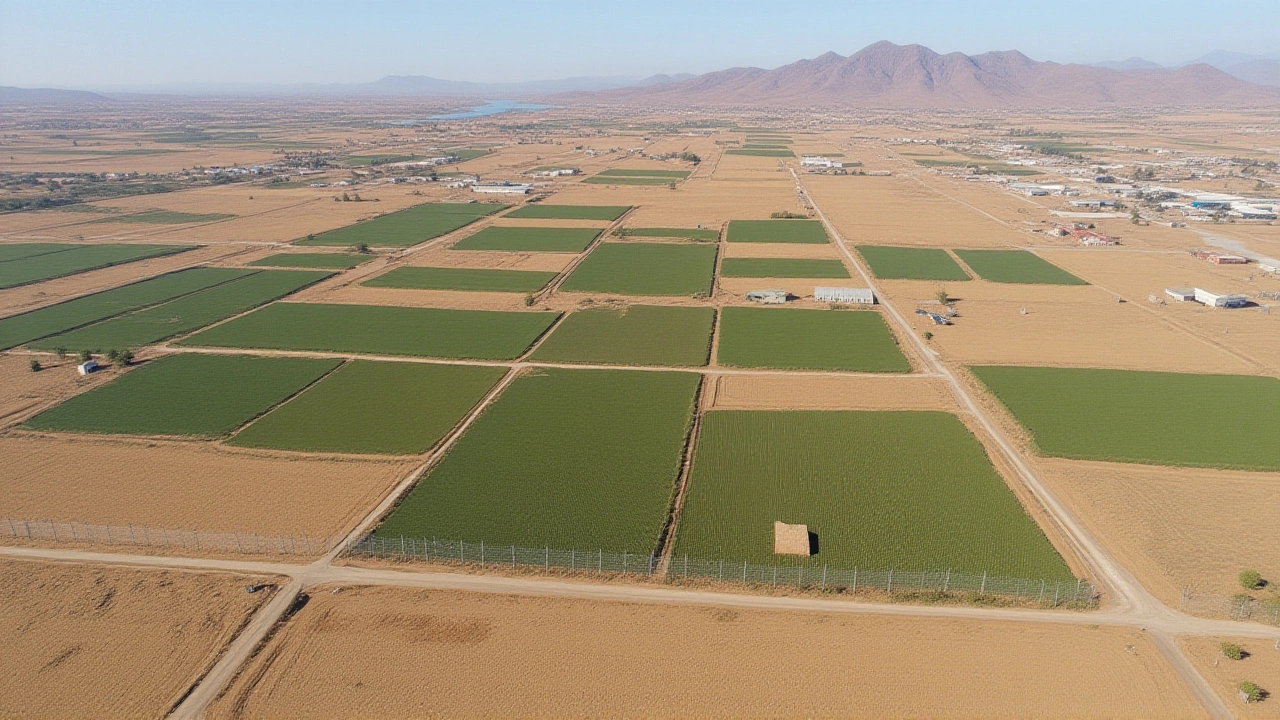When the lights flicker off in the middle of irrigation, the Berg River Valley’s agricultural community feels the pinch. To counter that, a handful of farms have joined a pilot programme with Eskom aimed at sidestepping the nation‑wide loadshedding that has become daily news.
How the pilot works
The crux of the project lies in marrying renewable power with on‑site storage. Solar panels line the roofs of farmhouses and pump stations along the Broodkraal feeder, feeding electricity straight into a bank of lithium‑ion batteries. When Eskom announces a load‑shedding stage, the system automatically switches to the stored energy, keeping pumps running and fields watered.
Beyond hardware, the programme introduces smart‑control software that predicts power‑outage windows based on Eskom’s schedule. Farmers can pre‑program irrigation cycles to run during off‑peak hours, trimming consumption and freeing up grid capacity for other users.
Early outcomes and farmer feedback
Within the first three months, participating farms reported a 70% drop in unplanned pump shutdowns. Crop stress indicators – such as leaf wilting and soil moisture dips – have improved, translating to a modest boost in yields for water‑intensive crops like tomatoes and beans.
- Energy savings: On average, each farm has cut grid reliance by about 45% during peak loadshedding periods.
- Cost impact: Lower electricity bills are offset by the upfront cost of solar panels, but Eskom’s subsidies covering 30% of installation expenses make the economics favorable.
- Scalability: The pilot’s modular design means additional farms can plug into the existing network without overhauling the system.
Farmers like Sipho Mthembu, who runs a 150‑hectare lettuce operation, say the pilot has given them “peace of mind”. He notes that before the project, a single two‑hour outage could ruin an entire day’s harvest. Now, he can keep his water pumps humming regardless of the national load‑shedding schedule.
Eskom’s regional manager, Thandiwe Ndlovu, frames the initiative as a test case for broader rural energy resilience. If the pilot meets its targets, the utility plans to roll out similar setups across other water‑dependent regions, potentially easing the strains on the national grid while supporting agricultural productivity.








George Thomas
September 28, 2025 AT 17:41The pilot illustrates a pragmatic integration of distributed generation and storage, enabling farms to insulate themselves from load‑shedding events. By leveraging on‑site solar and battery assets, the agricultural sector gains a degree of energy autonomy that could be replicated elsewhere. The reported reduction in pump interruptions underscores the operational benefit.
Michelle Linscomb
September 28, 2025 AT 19:54This is exactly the kind of bold move we need to stop South Africa’s perpetual blackouts!
John McDonald
September 28, 2025 AT 22:07The techno‑economic analysis reveals a favorable levelized cost of electricity (LCOE) when factoring in Eskom’s subsidy, translating into an attractive internal rate of return for participating farms. Capital expenditures are amortized over the battery lifespan, while operational expenditures drop markedly due to reduced grid reliance. Moreover, the modular architecture supports scalable deployment without substantial re‑engineering.
Zoe Birnbaum
September 29, 2025 AT 00:21Wow, that’s some serious forward‑thinking! It’s great to see farmers actually taking control of their power supply instead of just waiting for the next outage. This could set a benchmark for other water‑intensive regions.
Amber Brewer
September 29, 2025 AT 02:34The smart‑control software predicts outage windows by interfacing with Eskom’s schedule API, then automatically queues irrigation cycles during off‑peak periods. This pre‑emptive scheduling not only preserves crop health but also smooths demand peaks on the grid. Farmers can monitor battery state‑of‑charge via a mobile dashboard, ensuring transparency.
Kim Coulter
September 29, 2025 AT 04:47Energy independence is a cornerstone of national sovereignty; relying on a failing grid undermines our capacity to thrive. By embracing renewable micro‑grids, we reclaim agency and demonstrate resilience against systemic inefficiencies.
Michelle Toale-Burke
September 29, 2025 AT 07:01Love seeing real solutions in action 😊 The batteries keep the pumps humming even when the lights go out 🙌
Amy Paradise
September 29, 2025 AT 09:14Super exciting! 🌞🚜 This model shows how technology can literally keep the farm running despite the load‑shedding drama. Keep the updates coming!
Janette Cybulski
September 29, 2025 AT 11:27I feel for anyone whose crops suffered because of sudden blackouts, so it’s heartening to read about this pilot. It’s a reminder that innovative thinking can really make a difference on the ground.
Mildred Alonzo
September 29, 2025 AT 13:41Interesting pilot yeah its good but theres a few bugs in the system we need to fix
Elizabeth Bennett
September 29, 2025 AT 15:54While the initial results are promising, a thorough cost‑benefit analysis over a longer horizon is essential before scaling up nationwide.
linda menuhin
September 29, 2025 AT 18:07Wow this looks like a great step forward i think its gonna help lot of farmers thogh there might be some tehcnical issues lol
Jeff Abbott
September 29, 2025 AT 20:21Honestly, this sounds like a band‑aid solution that distracts from the real problem: the state's inability to manage its own power infrastructure.
Quinton Merrill
September 29, 2025 AT 22:34Nice work! 👍 The integration of solar + batteries is a clear path forward, especially if more utilities follow suit. 🌍
Linda Lawton
September 30, 2025 AT 00:47Don't be fooled – these pilots are just a smokescreen while the elites hide the truth about hidden energy agendas and suppressed technologies.
Ashley Bradley
September 30, 2025 AT 03:01The philosophical resonance of decentralised energy systems harkens back to agrarian societies where communities were self‑sufficient, cultivating both soil and sunlight without reliance on distant authorities. In that ancient model, the rhythm of sowing and harvesting was intimately tied to the natural cadence of day and night, a relationship now mediated by photovoltaic cells and lithium ions. When modern farms adopt such micro‑grids, they are not merely installing hardware; they are reenacting a form of covenant between humanity and the environment, a pact that respects the limits of the planet while asserting autonomy. This covenant challenges the hegemonic narrative that energy must be centrally produced and distributed, a narrative bolstered by legacy utilities that profit from opacity. By embedding storage at the point of use, the Berg River pilot reduces the systemic fragility that manifests as load‑shedding, a phenomenon symptomatic of over‑centralisation. The reduction in unplanned pump shutdowns thus becomes a metric of resilience, quantifying a shift from vulnerability to robustness. Moreover, the psychological impact on farmers-who report “peace of mind”-cannot be understated; certainty in power supply translates to steadier decision‑making and reduced stress. The integration of predictive software introduces a layer of foresight, echoing the ancient farmer’s reliance on observation of the stars, now replaced by algorithmic forecasting. As the pilot scales, the cumulative effect may ripple through the national grid, alleviating demand spikes that precipitate outages. This potential feedback loop serves as a living example of systems thinking, where local actions propagate macro‑level benefits. Yet, caution is warranted: the upfront capital outlay, even with subsidies, may present barriers to smallholders lacking access to financing. Policy frameworks must therefore evolve to democratise access, perhaps through cooperative ownership models. In the broader context of climate change, such renewable‑centric solutions align with carbon mitigation goals, offering a dual advantage of energy security and emissions reduction. The pilot also opens avenues for ancillary services, such as frequency regulation, where aggregated battery capacity could support grid stability. Ultimately, the Berg River initiative exemplifies a microcosm of a possible future where energy is clean, distributed, and resilient, inviting us to rethink entrenched infrastructural paradigms.
Joe Delaney
September 30, 2025 AT 05:14Interesting take but practical data matters.
Ruben Vilas Boas
September 30, 2025 AT 07:27Totally agree, the numbers speak louder than the poetry.